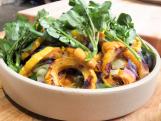Happy Chinese New Year! and Congrats on Not Being Eaten Alive

Ever wonder who came up with the idea that “everybody’s Irish” on St. Patrick’s Day? Whoever it was, I think most of America owes them a huge thank you, or at least a shot of Jameson. But why stop there? Isn’t it time we open ourselves up to the traditions and cuisines of other cultures — especially when the cuisine is insanely delicious? Today is Chinese New Year and it’s the perfect opportunity for everyone to “be Chinese” for a day.
Tonight at 8pm ET on Ching's Chinese New Year, host Ching-He Huang will share her “blueprint” for a fun and fortuitous Chinese New Year celebration, giving you the inside scoop on decorations, firecrackers and a mouthwatering Chinese feast that’s sure to bring you good luck in the year of the snake. Now, if you live in a city like San Francisco or New York, chances are you’re somewhat familiar with the loud and colorful festivities of Chinese New Year. (It’s hard to miss a huge red dragon marching down Main Street.) But why all the flare, you ask? It’s a holiday steeped in tradition and superstition, and it all begins with one fantastic legend. Gather around children; it’s story time:
Long ago, there lived a terrible and ferocious monster called “Nian” that lived on a mountain above a small village. At the start of every year, Nian would enter the village, devouring everyone and everything in its path, and so the people of the village lived in fear. Finally, one year a wise man came to the village and told the people that the monster was afraid of loud noises and the color red. Naturally, everyone in the village went and bought firecrackers and noisemakers, put red posters on their doors and, yeah, pretty much painted the town red. When the monster arrived, they fired off their fireworks and made a loud ruckus, scaring the monster off for good. Thousands of years later, free from the fear of Nian (which is also the Chinese word for “year), the Chinese spend New Year’s Day celebrating and feasting with family … but they still fire off those firecrackers and “paint the town red” like their lives depend on it. Because hey, if ridding your town of an evil, human-consuming monster isn’t worthy of a big party, than I don’t know what is. THE END
There you have it. Fireworks and bright red colors help keep the evil monster Nian at bay so that general merriment can occur. And what’s red and the culinary equivalent of a firecracker? Red, hot chili peppers, of course. No wonder the Chinese use them as liberally in their cooking as Americans do ketchup. Here are a couple of my favorite red-hot recipes from Ching’s blueprint menu to kick off your Chinese New Year with serious spice.
For starters, try your hand at folding up some of these gorgeous Golden Pork and Prawn Dumplings (pictured above). A crispy wonton shell gives way to a mix of tender, juicy mixture of pork and shrimp that’s infused with fresh garlic, ginger and spicy red Fresno chile pepper. Nian wouldn’t dare gobble you up after you’ve gobbled a few of these.

And for extra luck, try Ching’s Lucky Life Stir Fry (pictured above) Full of fresh and brightly colored vegetables (and yes, more red hot chile), this dish is as healthy as it is festive. Serve it over steamed rice as a satisfying vegetarian main dish or else alongside Ching’s Soy Spice Roast Chicken as an eye-catching side. Either way, make sure you tune in tonight, Sunday, February 10, at 8pm ET for Ching’s Chinese New Year for more recipes and tips to bring you good fortune. Xin Nian Kuai Le (Happy New Year) everyone!











